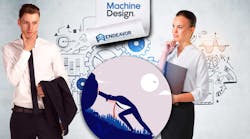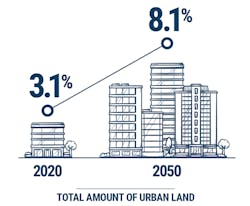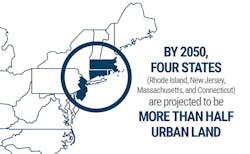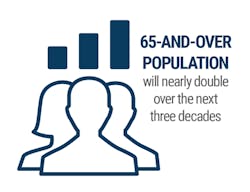Engineering Your Career (Part 1): Challenges Facing the Profession
This article is part of the Professional Advancement Series: Engineering Your Career
This article appeared in Machine Design and has been published here with permission.
Engineering entails solving societies’ real-world problems using machines, systems, materials and processes. There are many different engineering disciplines and diverse specializations, but all involve solving problems for people and therefore they all inherently affect society.
This means licensed professional engineers are ethically obliged to hold paramount the health, safety, and welfare of the public. Although our country and the world looked different in 1946 when the National Society of Professional Engineers (NSPE) endorsed its first code of ethics, engineers’ obligation to the public has become more important than ever as the infrastructure and technology around us become ever more complex.
As the world rapidly changes, the problem-solving skills that are foundational to engineering are needed now more than ever. Here are just a few trends that may alter our profession.
Population Growth and Urbanization
According to census data, the U.S. population is projected to grow from 326 million to 400 million between 2020 and 2051. Plus, over the last several decades, there has been a consistent shift of population from rural to urban areas. Although the COVID-19 pandemic may have forced people to work from home and seek out more rural settings, which slowed migration into the cities, urbanization is likely to continue. In fact, 2020 data shows about 57 million people living in rural U.S. and 273 million people in urban areas.
And cities are growing in size, as well. It’s predicted the total amount of urban land will climb from 3.1% of all the land in the U.S. in 2000 to 8.1% in 2050 and encompass an area larger than Montana. By 2050, more than half of some states (e.g., Rhode Island, New Jersey, Massachusetts, and Connecticut) is projected to be urban land.
Meanwhile, U.S. forested land that equals the size of Pennsylvania will be bulldozed into city land between 2000 and 2050. If these projections bear out, professional engineers will likely be called on to improve the aging and undersized infrastructure in urban cores as well as expand the infrastructure to accommodate sprawling suburbs.
Aging Population
In the U.S., the population is growing older, which creates challenges for engineers. For example, the decline in the number of working-age people means a smaller supply of qualified workers, making it difficult for businesses to fill in-demand jobs. An economy that cannot fill these in-demand occupations faces harmful consequences, including declining productivity, higher labor costs, slower business expansion and reduced international competitiveness.
Other concerns include the rise in healthcare costs and the growing need for healthcare that increases with age. Countries with rapidly aging populations must devote more money and resources to healthcare. And with healthcare spending as a share of gross domestic product already high in most advanced economies, it is difficult to increase spending and ensure care improves.
Countries with large elderly populations must also rely on smaller pools of workers to pay taxes for higher health costs, pension benefits and other publicly funded programs. This is becoming common in advanced economies in which retirees live on fixed incomes that place them in lower tax brackets than active workers. The combination of lower tax revenues and higher spending commitments is a major concern for advanced industrialized nations.
2020: Pandemic and Social Upheaval
It is apparent that although the pandemic did not necessarily create change, it has certainly accelerated it. For example, although working across international borders has become more common than in previous decades and national economies more interdependent, the pandemic-spawned “work from home” or “work from anywhere” movement shrunk the world even more. Businesses that once operated in just a few states have employees living all over the U.S., which has business implications. Additionally, clients no longer seem to put as much value on being “close” to their vendors if work is getting done on time and meets quality expectations. It is unknown if this attitude change will persist, but a reversal to pre-COVID times is highly unlikely.
While not associated with the pandemic, 2020 also brought an increased focus on social and racial injustice in the U.S. It is now a business imperative for all companies and organizations to focus efforts on diversity, equity, and inclusion (DEI). Potential employees will decide to join a company base not only on compensation and benefits, but also on the firm’s culture and DEI efforts.
Workforce Pipeline
The aging population presents engineering challenges and opportunities related to the workforce pipeline. In the U.S., 10,000 Baby Boomers turn 65 every day, and the 65-and-over population will nearly double over the next three decades. Nearly 19,000 engineers, many still working, will turn 69 each year for the next 15 years.
Many companies and organizations have been preparing for this situation. However, have they prepared well enough? Have they thought of all the ramifications and taken action to address the issues? We are at risk of losing critical history and knowledge. No matter the organization, everyone is feeling the effects of the aging engineering population and the knowledge gap.
A focus on workplace diversity seems a logical step in solving the workforce pipeline challenges. Filling the void created by retiring Baby Boomers will require a more diverse pipeline and retaining women and minorities in the profession. For years, the number of female graduates has increased to as much as 50% in fields such as environmental engineering. Challenges persist, however, in retaining these women in engineering as their careers develop. Engineering leaders need to address the issue of inclusion within engineering to keep up with future demands.
Emerging Fields
There is no doubt industry will develop and implement new and better technologies, often at breakneck speeds. Although new technologies are not inherently bad, they should be developed so that they protect public health, safety, and welfare. Professional engineers must play significant roles in developing new products and services, rehabilitating the infrastructure and managing vital subsystems.
As technology advances, there should be caution regarding complex software that shifts routine engineering tasks from engineers onto technicians or even end-users. When products are designed and built with minimal human involvement—perhaps without even a professional engineer—the public can be put at risk. Although it’s easy to discount the role of humans as technology does more “thinking and creating,” engineers must embrace this change while continuing to protect the public.
Climate Change
Engineers will also play key roles in addressing climate change by reducing the contributing effects or mitigating the repercussions of climate changes on the infrastructure and natural resources. The NSPE’s "2020 Engineering Outlook & Salary Survey" shows that respondents younger than 25 believe engineers must actively engage on this issue. They are eager to solve climate challenges.
Furthermore, engineers will need to innovate and create new models, products, and services to reduce climate effects. They will need to revise standards and develop design processes that protect people and resources. Maybe most importantly, engineers will need a seat at the table with decision-makers to offer expert advice on avoiding and reducing risks.
Engineering Licensure
As discussed, the world is changing, which brings challenges and opportunities. Changes are happening in education, regulation, public opinion and technology, all of which affect PE licensing. As the future unfolds, it is important to remember that engineers are stewards of technology, the natural and built environments, and public health, safety, and welfare. PE licensing, however, was not created to readily support the vital role of engineers in these times.
Professional engineering licensing started during the second industrial revolution, with the first state license issued in Wyoming in 1907. NSPE was formed in 1935 with the goal of spreading licensing across the U.S., a goal achieved during the third industrial revolution.
Now the world is in the fourth Industrial Revolution; has PE licensing kept up to date? For example, consider software engineering. While the number of (and the need for) software engineers grow, the number of candidates seeking PE examination in that field dropped so low the exam was recently eliminated. This prevents software engineers from obtaining a PE license. With technological advances transforming how engineers work and interact, engineering licensure must be transformed.
Although governments have traditionally shaped the societal effects of new technologies, they struggle to keep up with the rapid change, making engineers’ professional judgment even more important.
Most engineers are responsible for activities that affect public health, safety and welfare, but there are exemptions to state PE licensing laws that let certain individuals and organizations perform engineering services outside the licensing system. Exempt individuals and organizations are not subject to the same legal and ethical requirements as those with PE licenses. These exemptions undermine the purpose of engineering licensing and risks leaving the public in danger of receiving services from individuals without the qualifications for making engineering decisions that adequately protect public health, safety and welfare.
For the engineering profession, moving into the 2020s and beyond comes with exciting opportunities and daunting challenges. But history is filled with examples in which engineers rose to meet great challenges and seize new opportunities. I am confident professional engineers are up to the task today.
Tricia Hatley, P.E., is the immediate past president of the National Society of Professional Engineers.
Read more from the Professional Advancement Series: Engineering Your Career




